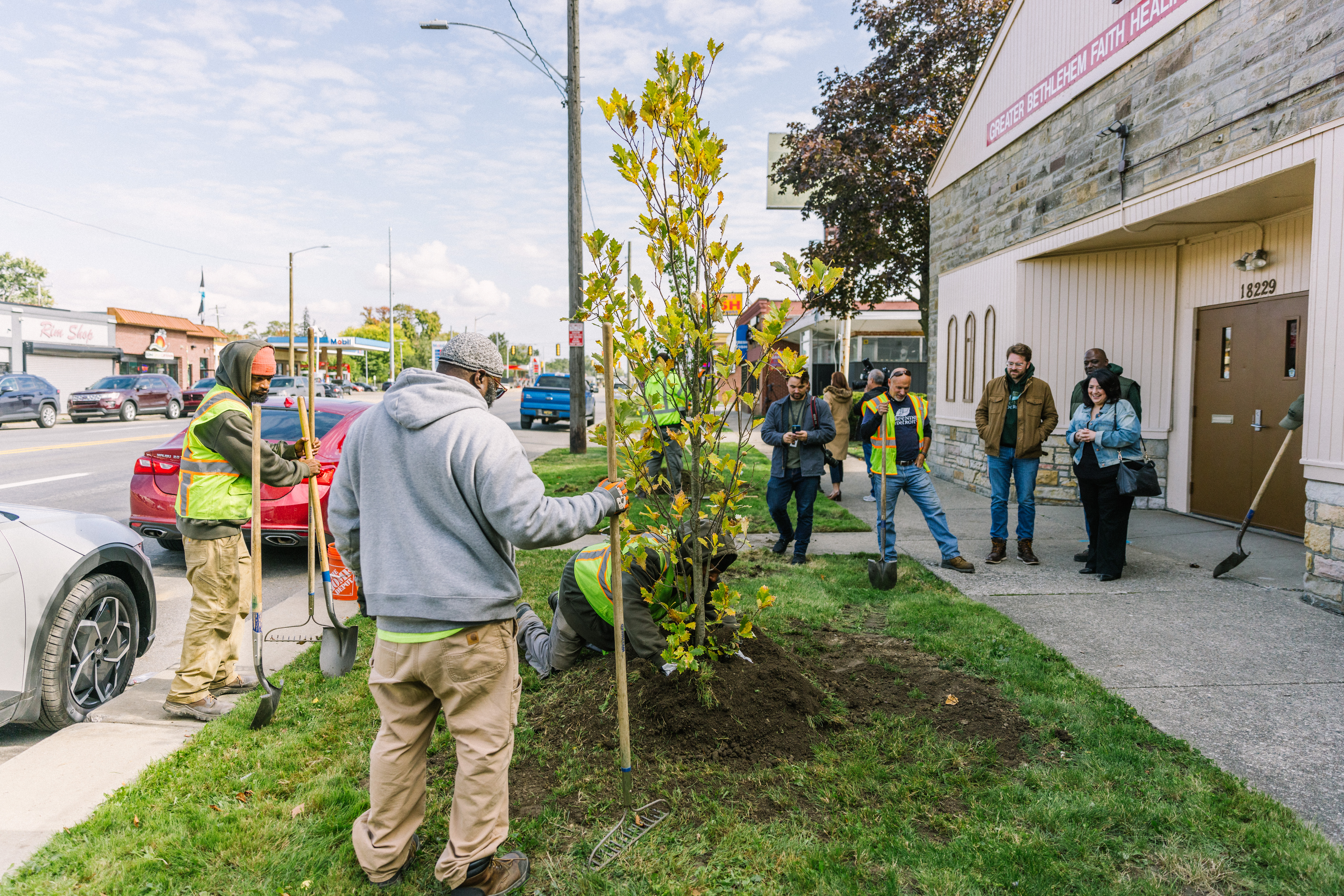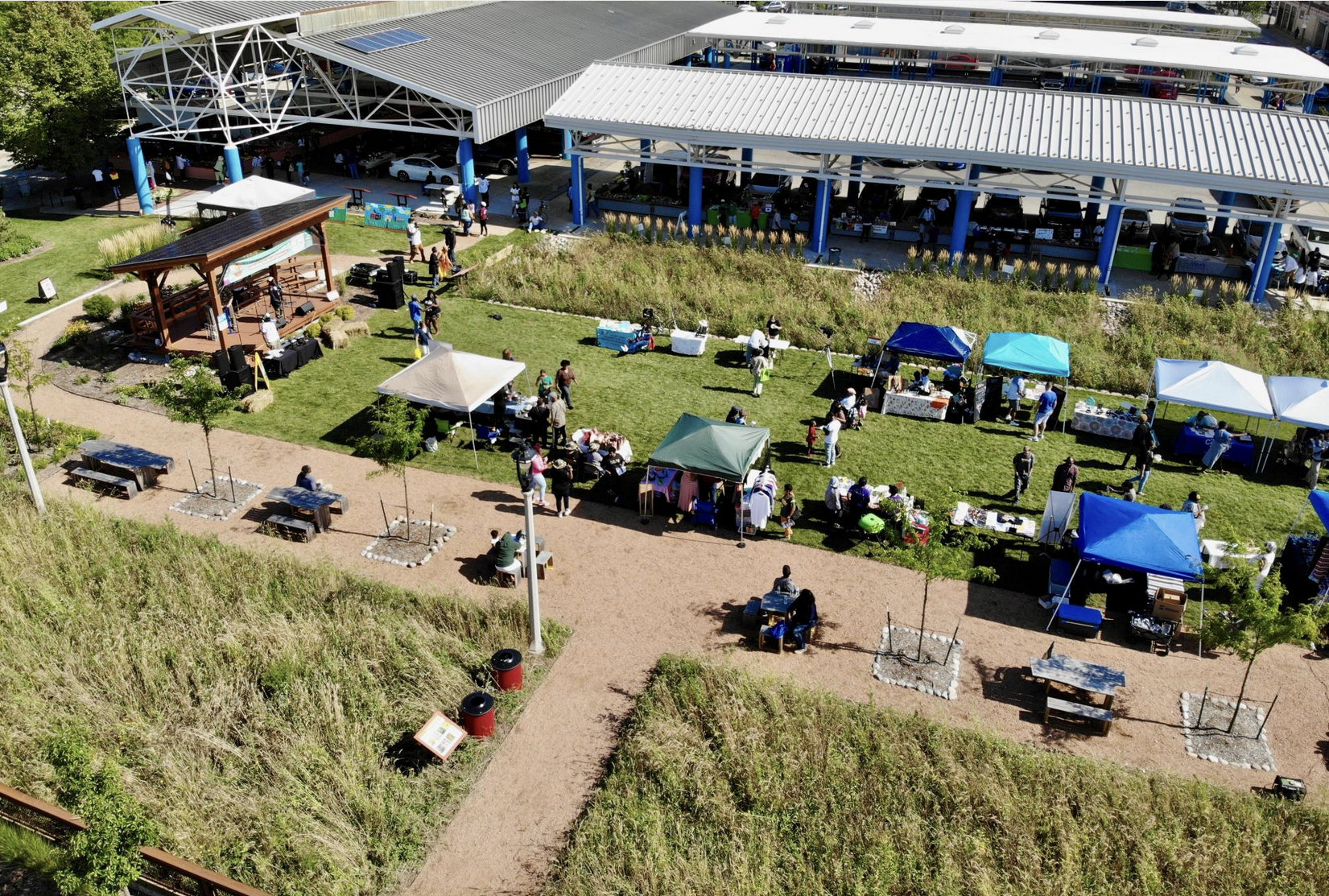Below you’ll find statements from city officials in Chicago, Cleveland, Detroit, Milwaukee, Windsor, and Toronto — published exactly as received. This is part of Great Lakes Now’s wide-reaching story on heat islands around the region. For more information, check out part one and part two of our investigation into the connection between heat and health, the role of the Great Lakes, what’s being done, and where these cities have room to improve.
Chicago

Raed Mansour, Director of the Office of Innovation at the Chicago Department of Public Health (CDPH), explains how to use the National Oceanic and Atmospheric Administration (NOAA) tools to gather data for Heat Watch 2023.
From the Chicago Department of Public Health (CDPH):
CDPH has currently moved into the next phase of work to build a community-driven, public health-based Heat Vulnerability Index (HVI) after we completed Heat Watch 2023. With our continued partnership with the Northwestern University Buffett Institute’s Defusing Disasters Working Group, we are currently completing work with our Governance Advisory Committee to co-develop a structure that fully incorporates community members into the co-development of the HVI. More on our development of the HVI can be found in this Buffett Brief. One example of an immediate use of the Heat Watch project went into Our Roots Chicago, a five-year plan to equitably plant 75,000 trees.
Cleveland
Here are some notes from Director Sarah O’Keeffe, Director of Climate Justice and Sustainability for the City of Cleveland:
- Cleveland has completed a Climate Risk and Vulnerability Assessment in early 2024, where heat was listed as a top risk to vulnerable populations, including outdoor workers, those experiencing homelessness, those with disabilities / medical conditions
- The city is actively updating its Climate Action Plan in 2024 to include and strengthen strategies to address heat and other risks and vulnerabilities where they occur the most often and most severely; nature-based solutions that increase green space and tree canopy coverage will address the impacts of urban heat island effect, while actions such as decreasing dependence on fossil fuels in energy use and transportation will address the root causes of climate change – greenhouse gas emissions
The DOE Energy Efficiency and Conservation Block Grant funding allocated to Cleveland through the Bipartisan Infrastructure Act will be used to created increased resiliency for at least two Neighborhood Recreation and Resource Centers (NRRCs) that function as cooling centers – this short-term action is part of a longer-term plan to put the city’s NRRCs on the pathway to become Resilience Hubs using the Urban Sustainability Directors Network model
Detroit

The city of Detroit plans to plant more than 75,000 trees to mitigate the long-term urban heat island effect.
Below is a response from Theresa Mcarleton, Chief Parks Planner for City of Detroit’s General Services Department:
Yes, the City of Detroit evaluates every park’s ‘Heat Risk.” Doing this then informs decisions on where more trees should be planted, additional vegetation and GSI (green storm water infrastructure) can be added to decrease heat risk. Our Parks & Recreation Strategic Plan includes the following section:
“.2 HEAT RISK Areas of Increased Temperature due to Urban Heat Island Urban Heat Island Effect measures the increase in temperatures in urban areas, as shown below, ranging from 1, slightly above Detroit’s mean temperature, to 5, significantly above the mean. Parks are a vital part of the city’s green infrastructure by contributing cooling green spaces, which can also mitigate flooding (see Chapter 3 pages 24-26). Higher temperatures lead to poor health outcomes, like heat stroke. It is important to understand where the hottest areas of the city are so DPRD can prioritize interventions that reduce temperatures. Parks near high temperature areas can be targeted for increased vegetation and tree canopy cover to decrease temperatures and provide shade. They can also be a good target for cooling amenities such as splash pads or water play.”
Here is additional information from our tree planting manager, Whitney Smith. It comes from a perspective beyond the parks:
The City’s Sustainability Action Agenda and Climate Action Strategy outline goals for addressing urban heat island. Tree planting is our primary mitigation strategy to accomplish these goals. Plantings are targeted in communities with elevated heat island and those with less than 20% canopy cover. Since fall of 2022 the City in collaboration with the Detroit Tree Equity Partnership have planted over 17,000 trees in neighborhoods, parks, commercial corridors and freeways to address heat island and improve air quality.
Milwaukee
From the City of Milwaukee Health Department (MHD):
In the short term, the City of Milwaukee Health Department (MHD) helps support the Milwaukee County Office of Emergency Management during extreme heat events by helping set up cooling sites around the city. Alongside County-run sites, MHD issues public messages through various outlets, including social media, MHD’s website, and local news media, reminding residents of the dangers of heat-related illnesses and providing important tips for staying safe while working or playing outdoors. MHD also coordinates with the Mayor’s office and the Milwaukee Public Library in setting up and staffing additional cooling sites, if needed.
City of Milwaukee Health Department – Hot Weather Safety
Cooling Sites in Milwaukee County
MHD does not treat patients for heat-related illnesses. Anyone experiencing symptoms of heat-related illness should seek medical attention, or call 911 for emergency assistance, or dial 211 for non-emergency assistance.
In the long term, Milwaukee’s Environmental Collaboration Office, particularly through its Climate and Equity Plan, outlines the City’s initiatives to address heat-related issues. The plan focuses on two main goals:
- Reducing community greenhouse gas emissions by 45% by 2030 and achieving net zero emissions by 2050.
- Improving racial and economic equity by creating green jobs that pay at least $40,000, with an emphasis on recruiting local people of color.
For more details on the plan and its strategies, please refer to the links below:
Milwaukee Climate and Equity Plan
From the City of Milwaukee Department of Public Works:
The City of Milwaukee is committed to green infrastructure and ensuring residents have access to green spaces and all of the benefits they provide. In 2018, a city ordinance was revised to require all large developments and redevelopments of an acre or more to capture at least the first 1/2 inch of rainfall using green infrastructure. In June 2019, the Common Council approved the City’s Green Infrastructure Plan focused on the greening of schools, streets, libraries, development, lots, and jobs. The Plan prioritizes locations, practices, capture goals, financing mechanisms, policy, and stakeholders and builds on the City’s previous green infrastructure and climate adaptation efforts. The City also has an official climate and equity plan. Just last year, The City was awarded a $12 million federal grant to plant more trees in historically disadvantaged parts of the city. We also have the Milwaukee Urban Forestry Fund where groups and neighbors can apply to have 10-50 trees planted to improve tree equity. We are doing more construction products then ever before focused on creating spaces that are safe and enjoyable for people to walk, bike and drive. We are incorporating green spaces in those projects as much as possible. We have a number of bioswales that they city has created and maintains, and we are still creating more. We have a new dry pond that is being constructed near 31st and Capitol. This isn’t an exhaustive list, but I think this illustrates our commitment to green spaces, which have so many community benefits including combating problems like heat islands. In fact, we own and operate our very own 160 acre nursery and greenhouse with over 20,000 trees and 300,000 annuals, perennials, and shrubs.

Below please find a helpful list of links:
Green Infrastructure Commitment:
Green Infrastructure Plan:
https://city.milwaukee.gov/ImageLibrary/WCC/Images/GreenLots/FINALGIPLAN–reduced_2.pdf
Climate and Equity Plan:
https://storymaps.arcgis.com/stories/b3c3db305fc649a2bfb16dcaad7fa048
Urban Forestry Fund:
https://city.milwaukee.gov/dpw/operations/forestry/Urban-Forestry-Fund
Dry Pond:
https://x.com/milwaukeedpw/status/1788591282140418513/photo/1
Windsor
Statement from Karina Richters at the Windsor Parks Department:
Some of our early work was supported by Health Canada. This work can be found on the City’s Website Urban Heat Island | City of Windsor (citywindsor.ca). This includes the Urban Heat Island Report and the Improving Thermal Comfort in City Parks and Playgrounds reports.Some of the recommendations from the second report were then brought into the Parks Master Plan. In the last couple of years, the City of Windsor has built over 20 shade structures, 4 Splash Pads and added drinking water fountains to help reduce the risk of extreme heat on visitors to our Parks.
It’s also nice to note that our early work with Health Canada was the start of the conversation that was built upon and eventually led to the development of Annex K – Thermal Comfort under CSA Z614:20 (Children’s playground equipment and surfacing).
We have also coordinated with Environment Canada and Climate Change and ERCA to include urban heat island mapping to their public mapping site. ArcGIS – NRCan Data – LST & NDVI
Addressing the Urban Heat Island and Extreme temperatures are highlighted in the City’s 2020 Climate Change Adaptation Plan with numerous actions to be undertaken, particularly under Objective 7: Build Community Resilience.
The City of Windsor Parks department has been instrumental in supporting a number of these initiatives and more importantly implementing recommendations into Parks design. The City of Windsor is also in the process of developing an Urban Forestry Management Plan– that will go a long way to addressing the Urban Heat Island.
Toronto
Response by Toronto Public Health Spokesperson Dr. Howard Shapiro, Associate Medical Officer of Health:
In Toronto, the general trend has been towards more extremely hot days and prolonged heat. As noted in Toronto Public Health’s (TPH) November 2023 Board of Health report, Public Health Impacts of Climate Change in Toronto: A Path Forward for Responding to the Climate Crisis, climate modeling suggests that by 2049, Toronto will experience over three times as many annual days where the temperature exceeds 30 degrees Celsius.
Extreme heat is associated with many health impacts ranging from heat stress and heat stroke to more serious effects, such as cardiovascular-related disease and/or death. Everyone is vulnerable to the effects of extreme heat, but certain groups of people are more at risk than others. These groups include older adults, infants and young children, people with chronic illness (e.g., breathing problems, mental illness, and heart problems) or who are physically impaired, socially disadvantaged communities and individuals (low income, experiencing homelessness, and living alone), people who work in the heat including outdoor workers, and people who are physically active outside. TPH and Environment and Climate Change Canada (ECCC) estimate that heat contributes to an average of 120 premature deaths per year in the city.
In Canada, ECCC issues Heat Warnings. A Heat Warning is issued for southern Ontario (including Toronto) when there is a forecast of two or more consecutive days with daytime maximum temperatures of 31°C or warmer, together with nighttime minimum temperatures of 20°C or warmer or when there is a forecast of two or more consecutive days with humidex values expected to reach 40 or higher.
To reduce heat-related illness and death due to extreme heat, the City of Toronto has developed a protocol for hot weather response, Toronto’s Heat Relief Strategy. Since 2000, the Hot Weather Response Coordinating Committee has developed, monitored and continuously improved Toronto’s response to hot weather. The Strategy outlines the approach, roles and responsibilities of Committee members in providing City-wide heat relief services as directed by Toronto’s City Council.
The 2024 Strategy includes services such as the Heat Relief Network. Toronto’s Heat Relief Network maximizes the use of existing air-conditioned and other cool spaces on hot days. The City’s Heat Relief Network features cool spaces that are open throughout the summer, including on days when Heat Warnings are issued by Environment and Climate Change Canada. The Heat Relief Network includes libraries, community centres, shelters, drop-ins, 24-hour respite sites, and several private and non-profit organizations including some senior centres, shopping malls and YMCA locations.
Additional services that are available as part of the Heat Relief Strategy include:
- Public messaging through the City’s website, social media, traditional media, and traditional media.
- Cool Spaces in Apartment Buildings: Measures coordinated by the City to ensure cool spaces are readily available in apartment buildings and other multi-unit residences during the hot weather season
- Street Outreach: The City’s Streets to Homes outreach team does wellness checks for clients who live outdoors, and can support in determining the closest cool space.
- Extended Hours of Operation for Public Pools: During active Heat Warnings, the City’s Parks, Forestry & Recreation division will provide additional cooling opportunities for the public by extending pool hours until 11:45 p.m. at the seven outdoor pool locations across the city.
The City of Toronto has also been a participating city in the Partnership for Healthy Cities (PHC) initiative. This summer, PHC will provide funding for the City to implement a survey of Toronto residents regarding awareness and behaviours related to heat events, so we can better understand the distribution of risks of exposure to heat and health harms, residents’ adaptive capacity, and the potential for health impacts in the population. The proposed project builds on a survey conducted by TPH in 2010, which focused on access to cooling and exposure to extreme heat. More information about the survey is available in the April 2024 BOH report Partnership for Healthy Cities – Seeking Authority to Receive External Funds for the 2024 Budget Year.
In 2019, the City created the Heat Relief Working Group, led by the Deputy City Manager Corporate Services in partnership with Toronto’s Medical Officer of Health. The Group was tasked with piloting an action plan that included an expanded heat relief network, education, a neighbour checking program, the addition of shade structures, and review of bylaws with Municipal Licensing and Standards. The Group also focused on developing long-term strategies to mitigate the impacts of heat, including the urban heat island effect, and identifying funding sources and a lead division to coordinate the implementation of the strategies.
As noted in the City of Toronto’s first Resilience Strategy, one of the actions identified was reducing the urban heat island through the installation of green infrastructure such as expanding Toronto’s tree canopy. The City of Toronto plants and maintains trees on City land, to help grow Toronto’s urban forest and to reach the City’s goal of increasing the tree canopy to 40 per cent by 2050. More information is available in this May 27, 2024, news release and here: https://www.toronto.ca/services-payments/water-environment/trees/tree-planting/?accordion=tree-equity.
In addition, the City is:
- Updating local climate projections so that we can easily describe expected future weather including extreme heat and plan for it as a City
- Carrying out a risk and vulnerability assessment, which will provide updated information about extreme heat risks facing the City
- Working towards a more coordinated, integrated and equitable city-wide approach to making city assets, services and communities more resilient to the effects of climate change including extreme heat.

